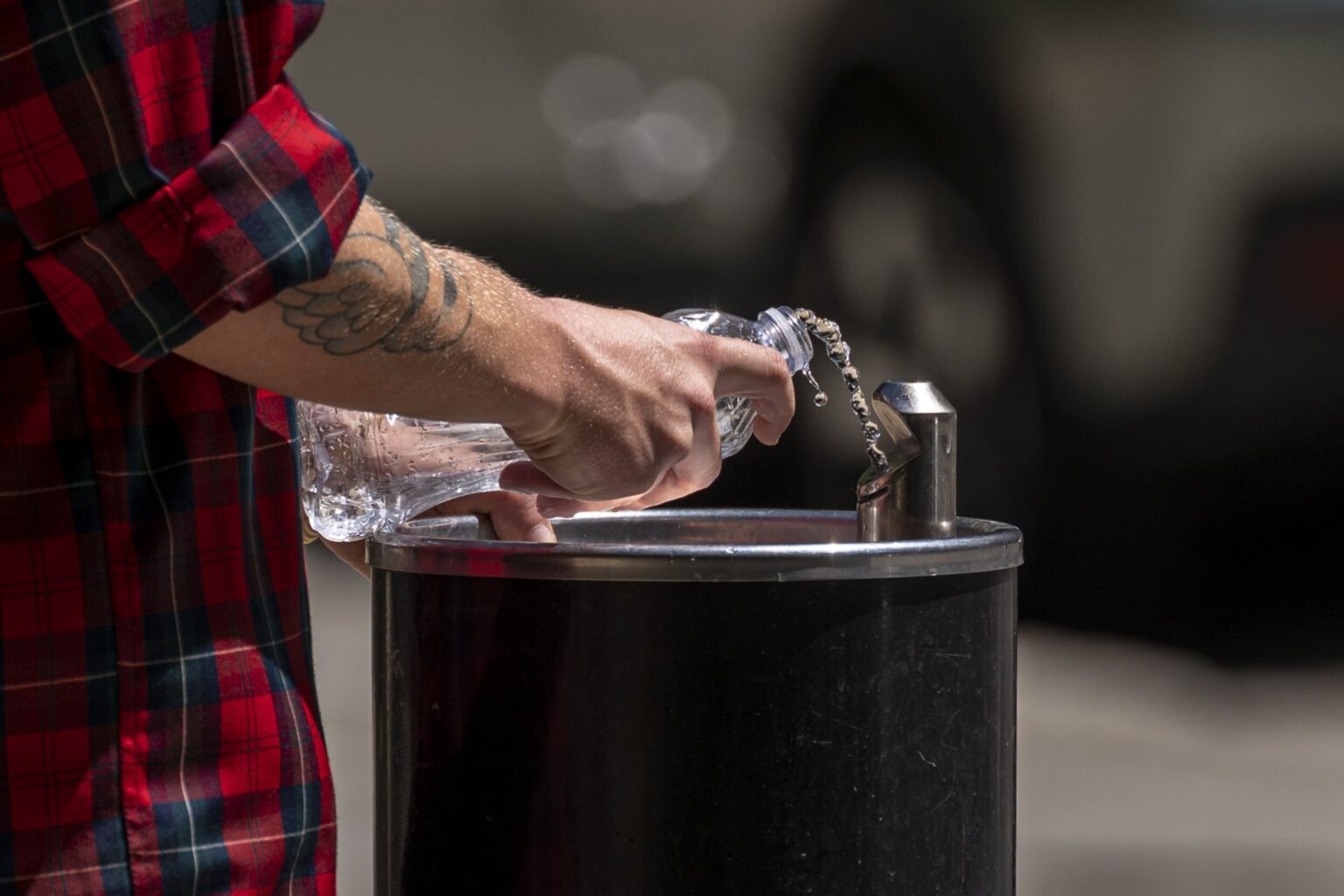New Mexico
'Forever Chemicals' Found in Water Sources Around New Mexico, Studies Find

So-called forever chemicals have been found in water sources across New Mexico, according to recent studies by the U.S. Geological Survey and state environment officials.
The federal agency detailed the findings last week, around the same day the U.S. Environmental Protection Agency announced its first-ever limits for several common types of PFAS, or perfluoroalkyl and polyfluoroalkyl substances.
Used in everyday products from nonstick pans and firefighting foam to waterproof clothing, PFAS have been linked to cancer and other health problems in humans. They are known as forever chemicals because they don’t degrade in the environment and remain in the bloodstream.
The research in New Mexico detected PFAS in all major rivers in the arid state, with the highest concentrations downstream of urban areas.
USGS researchers looked more closely at water quality in the Rio Grande as it flows through Albuquerque, New Mexico’s largest city, and found PFAS levels downstream that were about 10 times higher than at upstream locations.
Dozens of samples also were taken from groundwater wells and surface water sites as part of an initial statewide survey between August 2020 and October 2021, with officials saying the majority of wells sampled did not turn up PFAS. The work began after contamination was discovered at military installations.
Andy Jochems of the Environment Department’s water protection team said the latest findings will be helpful as regulators make decisions about protecting drinking water resources in the future.
Kimberly Beisner, a USGS hydrologist and lead author of the studies, said the work highlights the complex nature of chemicals in urban areas and their effects on river systems. She noted that concentrations near cities are constantly changing due to wastewater discharges and stormwater runoff, for example.
The utility that serves the Albuquerque area has not seen any PFAS concentrations in the drinking water system approaching the EPA limits, so officials said Wednesday they aren’t anticipating that the new regulations will require any action other than continued monitoring and reporting.
As for contaminants from Albuquerque going into the Rio Grande, utility spokesman David Morris said it’s possible that at some point there may need to be enhancements at the city’s sewage treatment plant.
Copyright 2024 Associated Press. All rights reserved. This material may not be published, broadcast, rewritten or redistributed.
Topics
Chemicals
Mexico
New Mexico
Interested in Chemicals?
Get automatic alerts for this topic.

New Mexico
The 'Passion' returns to the New Mexico Performing Arts Society

New Mexico
CDC: 'Vampire facials' at an unlicensed spa in New Mexico led to HIV infections in three women
Three women were diagnosed with HIV after getting “vampire facial” procedures at an unlicensed New Mexico medical spa, the Centers for Disease Control and Prevention said in a report last week, marking the first documented cases of people contracting the virus through cosmetic services using needles.
Federal health officials said in a new report that an investigation from 2018 through 2023 into the clinic in Albuquerque, VIP Spa, found it apparently reused disposable equipment intended for one-time use, transmitting HIV to clients through its services via contaminated blood.
WHAT IS A VAMPIRE FACIAL? IS IT SAFE?
Vampire facials, formally known as platelet-rich plasma microneedling facials, are cosmetic procedures intended to rejuvenate one’s skin, making it more youthful-looking and reducing acne scars and wrinkles, according to the American Academy of Dermatology.
After a client’s blood is drawn, a machine separates the blood into platelets and cells.
The plasma is then injected into the client’s face, either through single-use disposable or multiuse sterile needles.
Vampire facials have gained popularity in recent years as celebrities such as Kim Kardashian have publicized receiving the procedure.
HIV transmission via unsterile injection is a known risk of beauty treatments and other services, officials say.
Despite this, the Academy says vampire facials are generally safe.
Health officials say spa facilities that offer cosmetic injection services should practice proper infection control and maintain client records to help prevent the transmission of bloodborne pathogens such as HIV.
HOW WERE THE HIV CASES LINKED TO THE SPA?
The New Mexico Department of Health was notified during summer 2018 that a woman with no known HIV risk factors was diagnosed with an HIV infection after receiving the spa’s vampire facial services that spring.
Four women — former spa clients — and one man — the sexual partner of one of the spa clients but who did not receive services at the spa himself — received HIV infection diagnoses there during 2018-2023. Analysis showed similar HIV strains among all cases, according to the CDC’s report last week.
The HIV diagnoses for two of these patients “were likely attributed to exposures before receipt of cosmetic injection services,” according to the CDC.
Evidence suggested that contamination from services at the spa resulted in the positive HIV infection tests for the other three patients.
Health officials found equipment containing blood on a kitchen counter, unlabeled tubes of blood and injectables in the refrigerator alongside food and unwrapped syringes not properly disposed of. The CDC report said that a steam sterilizer, known as an autoclave — which is necessary for cleaning equipment that is reused — was not found at the spa.
ARE ANY OTHER PATIENTS AT R
ISK?
Through the New Mexico Department of Health’s investigation, nearly 200 former clients of the spa, and their sexual partners, were tested for HIV, and no additional infections were found.
According to the CDC, free testing remains available for those who previously frequented the spa.
WHAT HAPPENED TO THE SPA OWNER?
The former owner of VIP Spa, Maria de Lourdes Ramos de Ruiz, pleaded guilty in 2022 to five felony counts of practicing medicine without a license, including conducting the unlicensed vampire facials.
The New Mexico Attorney General’s office said Ramos de Ruiz also did illegal plasma and Botox-injection procedures.
According to prosecutors, inspections by state health and regulation and licensing departments found the code violations, and the spa closed in fall 2018 after the investigation was launched.
Ramos de Ruiz was sentenced to 7 1/2 years, with four years being suspended on supervised probation, 3 1/2 years time in prison and parole, according to court documents.
Raul A. Lopez, attorney for Ramos de Ruiz, did not immediately respond to requests for comment.
___
Alexa St. John is an Associated Press climate solutions reporter. Follow her on X, formerly Twitter, @alexa_stjohn. Reach her at [email protected].
New Mexico
NM to meet with Pueblos in May on Rio Grande governance • Source New Mexico

The Rio Grande Compact Commission meeting on Friday had a small portion dedicated to describing future meetings with six Middle Rio Grande Pueblos to get tribal perspective on governing the state’s largest river.
The three-member commission met for its annual meeting Friday, hearing from legal advisors and New Mexico State Engineer Mike Hamman on the proposal. The commission is made up of appointees from Colorado, Texas and New Mexico and a non-voting chair from the federal government.
A coalition of six Pueblos – Cochiti, Santo Domingo, San Felipe, Santa Ana, Sandia and Isleta – have approached the commission for the past two years. Through spokespeople, the coalition said they sought a “seat at the table” to address the exclusion of tribal governments from the commission itself and to have more representation beyond the U.S. Bureau of Indian Affairs, who makes presentations at the meeting.
Pueblos again seek inclusion in Rio Grande decision-making
Legal and engineer advisors described “multiple multi-hour discussions” over a series of months but had not developed a protocol for Pueblos to make a presentation to the commission.
Hamman, during commissioner comments, expanded on that report, saying that other commission business, such as the lawsuit before the Supreme Court over Rio Grande water, caused competing priorities.
“The Rio Grande Compact Commission has been engaged on a number of really important issues that included Texas v. New Mexico Original No. 141 case, and a number of other matters that did not allow us to fully formalize any kind of proposal in that regard.”
Hamman said he met with coalition leaders on April 4, securing an agreement to consult with all tribal governments on the Rio Grande governance in May, as part of his duties in the Office of the State Engineer. He said this was modeled after tribal consultation efforts on the Colorado River.
He said the goal would be a half-day meeting used to develop the process for regular meetings between tribal governments and the Rio Grande Compact Commission.
“We also acknowledge that six Middle Rio Grande Pueblos have probably the most direct impact on operational issues associated with the Rio Grande compact. But with that said, we have a responsibility to consult with all of the tribes and basin,” Hamman said.
U.S. Bureau of Indian Affairs Engineer Sarah Delavan ceded some of her presentation time to the coalition, inviting Glenn Tenorio, the former governor of Santa Ana Pueblo and vice chair of the coalition, to address the commission.
Tenorio acknowledged that other Pueblo leadership was in attendance and read from a prepared statement.
He said the coalition was looking to learn more about tribal consultation in the Colorado River negotiations and determine if a similar model can be used for the Rio Grande.
“The coalition looks forward to working with the Commission in the coming months to find the most appropriate means of future engagement,” he said.
GET THE MORNING HEADLINES DELIVERED TO YOUR INBOX
-

 World1 week ago
World1 week agoShipping firms plead for UN help amid escalating Middle East conflict
-

 Politics1 week ago
Politics1 week agoICE chief says this foreign adversary isn’t taking back its illegal immigrants
-

 Politics1 week ago
Politics1 week ago'Nothing more backwards' than US funding Ukraine border security but not our own, conservatives say
-

 News1 week ago
News1 week agoThe San Francisco Zoo will receive a pair of pandas from China
-

 World1 week ago
World1 week agoTwo Mexican mayoral contenders found dead on same day
-

 World1 week ago
World1 week agoBrussels, my love? The EU single market is not sexy enough for voters
-

 Politics1 week ago
Politics1 week agoRepublican aims to break decades long Senate election losing streak in this blue state
-

 World1 week ago
World1 week agoEU sanctions extremist Israeli settlers over violence in the West Bank

















